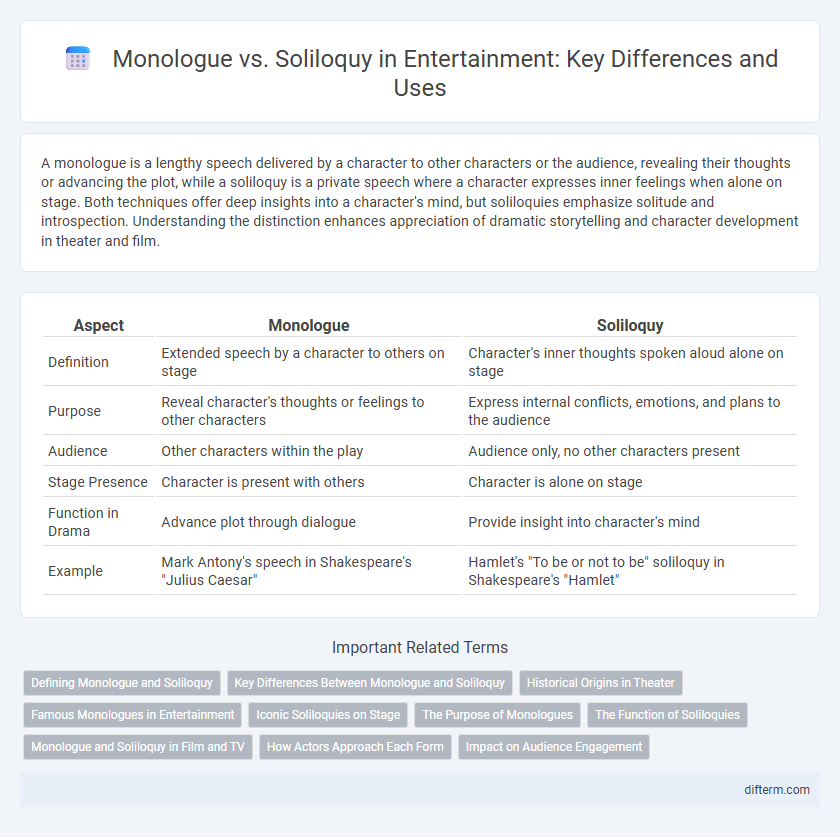A monologue is a lengthy speech delivered by a character to other characters or the audience, revealing their thoughts or advancing the plot, while a soliloquy is a private speech where a character expresses inner feelings when alone on stage. Both techniques offer deep insights into a character's mind, but soliloquies emphasize solitude and introspection. Understanding the distinction enhances appreciation of dramatic storytelling and character development in theater and film.
Table of Comparison
| Aspect | Monologue | Soliloquy |
|---|---|---|
| Definition | Extended speech by a character to others on stage | Character's inner thoughts spoken aloud alone on stage |
| Purpose | Reveal character's thoughts or feelings to other characters | Express internal conflicts, emotions, and plans to the audience |
| Audience | Other characters within the play | Audience only, no other characters present |
| Stage Presence | Character is present with others | Character is alone on stage |
| Function in Drama | Advance plot through dialogue | Provide insight into character's mind |
| Example | Mark Antony's speech in Shakespeare's "Julius Caesar" | Hamlet's "To be or not to be" soliloquy in Shakespeare's "Hamlet" |
Defining Monologue and Soliloquy
A monologue is a prolonged speech delivered by a single character to other characters or the audience, revealing thoughts, emotions, or information. A soliloquy differs as it involves a character speaking their inner thoughts aloud while alone on stage, offering direct insight into their mind. Both are key dramatic devices in theater, with monologues driving dialogue and soliloquies exposing personal reflection.
Key Differences Between Monologue and Soliloquy
A monologue is a long speech delivered by a character to other characters or the audience, revealing thoughts or advancing the plot, while a soliloquy is a speech where a character speaks their inner thoughts aloud, typically alone on stage, to provide insight into their mind. Monologues engage with other characters or the audience directly, whereas soliloquies are introspective and serve to expose internal conflicts without interaction. The key difference lies in their dramatic function: monologues influence external dynamics, and soliloquies reveal private emotions.
Historical Origins in Theater
Monologues and soliloquies have distinct historical origins in theater, with soliloquies tracing back to ancient Greek drama where characters expressed inner thoughts aloud to the audience alone, enhancing emotional depth. Monologues emerged as a broader dramatic device used in Roman and Elizabethan theater, serving both to reveal character motivations and advance the plot through extended speeches. Shakespeare's plays especially popularized the soliloquy, most famously exemplified by Hamlet's "To be or not to be," solidifying its role in theatrical storytelling.
Famous Monologues in Entertainment
Famous monologues in entertainment reveal a character's inner thoughts and emotions directly to the audience, distinguishing them from soliloquies, which are introspective speeches delivered alone on stage. Iconic examples include Hamlet's "To be or not to be" and Shakespeare's Macbeth's "Tomorrow, and tomorrow, and tomorrow," showcasing complex psychological depth. These monologues have become defining moments in theatre and film, highlighting dramatic tension and character development.
Iconic Soliloquies on Stage
Iconic soliloquies on stage, such as Hamlet's "To be or not to be," deliver an intense insight into a character's inner thoughts and emotions, allowing audiences an intimate psychological connection. Unlike monologues that address other characters or the audience, soliloquies reveal private reflections, enhancing dramatic tension and thematic depth in theatrical performances. Shakespeare's soliloquies remain seminal examples, shaping modern drama through their profound exploration of identity, morality, and existential dilemmas.
The Purpose of Monologues
Monologues serve as a powerful tool in entertainment to reveal a character's inner thoughts, emotions, and motivations directly to the audience, enhancing narrative depth. Unlike soliloquies, monologues can be delivered to other characters, facilitating interaction and advancing the plot. Their purpose often includes showcasing a character's personality, providing exposition, or creating dramatic tension within a scene.
The Function of Soliloquies
Soliloquies function as a dramatic device that reveals a character's innermost thoughts and emotions directly to the audience, providing critical insight often hidden from other characters. Unlike monologues, soliloquies are typically delivered in solitude, enhancing the psychological depth and advancing the plot through internal conflict exposition. This technique is essential in classical and modern theater for building character complexity and driving narrative tension.
Monologue and Soliloquy in Film and TV
Monologues in film and TV serve as powerful tools for character development, allowing actors to deliver extended speeches that reveal motivations and emotions directly to the audience or other characters. Soliloquies, distinctively, are introspective moments where a character expresses inner thoughts aloud, often breaking the fourth wall to provide insight without interaction from others on screen. Both techniques enhance narrative depth by unveiling complex psychological layers, but soliloquies are more commonly associated with classical adaptations, while monologues dominate contemporary cinematic storytelling.
How Actors Approach Each Form
Actors approach monologues by engaging directly with the audience or other characters, using clear articulation and emotional range to convey a self-contained narrative or argument. In contrast, soliloquies require actors to delve into introspection, expressing inner thoughts and emotions as if thinking aloud, often creating an intimate connection with the audience. Mastery of monologues involves external expression and audience awareness, while soliloquies demand subtlety and vulnerability to reveal the character's private psyche.
Impact on Audience Engagement
Monologues create direct interaction between the character and the audience, fostering a sense of connection through personal storytelling or persuasion. Soliloquies reveal the character's inner thoughts and emotions, allowing the audience intimate insight that deepens emotional engagement and understanding. Both techniques enhance audience involvement but soliloquies often generate a more profound psychological impact by exposing hidden conflicts.
monologue vs soliloquy Infographic

 difterm.com
difterm.com